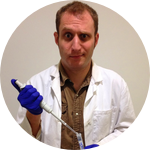About This Project
Our goal is to adapt portable genome sequencing technology for high-pressure, underwater environments. Currently, deep-sea organisms are sequenced at near 1 atmosphere of pressure, a pressure many of them would never live in naturally. If successful, this technology will enable researchers to sequence deep-sea organisms in their natural environment and thereby gain valuable information about how organisms express their genes in response to their unique environments.
Ask the Scientists
Join The DiscussionWhat is the context of this research?
Scientists have been able to culture less than 1% of the bacteria species on Earth [1]. Many of the most interesting bacteria live at the bottom of the ocean in high-pressure environments with no oxygen and no light. We currently know nothing about these bacteria or how their genomes are expressed in the context of their environment, questions which can only be answered in situ using underwater biosensors. The first step is to understand the effects of pressure on nanopore sequencing technology: how does pressure create errors in mobile genome sequencing? We believe that developing underwater nanopore biosensors will open entirely new areas of research.
What is the significance of this project?
The aim of this project is to adapt portable genome sequencing technology for high-pressure deep-sea environments. If successful, it will dramatically expand our knowledge of deep-sea species, the functioning of deep-sea ecosystems, and ultimately the planet. Biosensors adapted for deep-sea use would allow researchers to study how deep-sea organisms express their genomes in their natural environment while reducing or eliminating the need for physical samples to be brought up from the deep. This modular, portable sensor technology can be integrated with existing exploration survey platforms (ROVs, UMS, terrestrial and marine NASA landers, etc.) and could be used to develop time-series data that would lead to the discovery of important new attributes of ocean environments.
What are the goals of the project?
The goals of this project are to perform proof-of-concept experiments showing how the nanopore flow cell can perform at varying pressure. First we will complete the construction of a pressure vesselwith a nanopore sensor. Our preliminary design has been approved by our collaborators at Scripps Institution of Oceanography, Oxford Nanopore Technologies, and Global Ocean Design. We will then sequence three types of DNA at varying pressure, including a metagenomic sample mixture, simulating the diversity of environmental DNA found in the ocean [2]. We have allowed time for iterative technology development in our workflow.
Budget
Supplies and Materials:
(1) We will purchase all DNA from New England BioLabs. The total cost of DNA is around: $69.00+$66.00=$135.00.
(2) We plan to conduct eight proof-of-concept experiments. Three starter kits using the Oxford Nanopore Sensor (the MinION) will cost $3,276.00 ($1092.00 each).
(3) Additionally, modifying the pressure vessel at Scripps Institute of Oceanography so that it contains a USB-3 power connectiondata link will cost approximately $275. This cost is a rough, extremely conservative estimate. We will need to bring the USB-3 cable through the existing bulkhead connector on the pressure vessel. Global Ocean Dynamics, has years of experience adapting high pressure systems and foresees that this task is possible by fitting an existing connector from the group at no cost.
Endorsed by
 Project Timeline
Project Timeline
Phase 1: Using existing lab facilities, confirm nanopore sensor can operate at high pressure.
Phase 2: Confirm nanopore sensor can operate in the sea. This is imagined as a series of shallow water tests, 200-300m, of moderate duration to see what fluid pumps may need to be created, including, perhaps, a reverse flow, back flush/cleaning stream, or possibly shutters that close for the nanopore sensor head.
Phase 3: Field deployment of the advanced prototype.
May 15, 2021
Project Launched
Apr 01, 2022
Confirm nanopore sensor can operate at high pressure.
Apr 01, 2023
Confirm nanopore sensor can operate in the sea.
Apr 01, 2024
Field deployment of the advanced prototype.
Meet the Team
Keolu Fox, PhD
Keolu Fox is the first Kānaka Maoli to receive a doctorate in genome sciences. Keolu is a co-founder of the Native BioData Consortium (NBDC) and an Assistant Professor at the University of California, San Diego (UCSD), where he is a co-founder and co-director of the UCSD Indigenous Futures Institute. Keolu is also affiliated with the Halıcıoğlu Data Science Institute, the Department of Anthropology, the Global Health Program, the Climate Action Lab, and the Design Lab. Keolu's work focuses on the connection between raw data as a resource and the emerging value of genomic health data from Indigenous communities. He has experience designing and engineering genome sequencing and editing technologies, and a decade of grassroots experience working with Indigenous partners to advance precision medicine.
Lab Notes
Nothing posted yet.
Additional Information
We believe this exploratory series of experiments will be the first to quantify the effects of pressure on mobile nanopore-based genomic sensors. The experiments will serve as a proof of concept, generate preliminary data on the effects of pressure on nanopore-based genome sequencingsensors, and move towards the long term goal of engineering a deployable in situ nanopore genome sequencing sensor. It will complement the development of solid-state nanopores for deep-sea genetic sequencers.
Project Backers
- 17Backers
- 102%Funded
- $3,700Total Donations
- $217.65Average Donation

